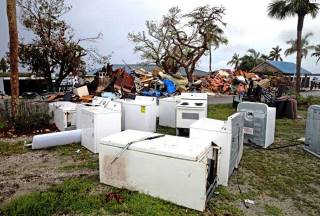|
America’s flood insurance chief has a message
for all Floridians: You’re at risk |
Article Courtesy of The Miami Herald
By Jenny
Staletovich
Published
March 7, 2018
If you’re a homeowner in Florida relying on flood
zone maps to decide whether to buy insurance, you may want to check your
drivers license instead.
|
"If it says Florida, you need flood
insurance," said Roy Wright, who oversees the Federal
Emergency Management Agency’s National Flood Insurance
Program, which covers more policies in Florida than any
other state. "It may be more helpful than trying to find the
right map."
Hurricane Irma is only the latest case in point, said
Wright, who was in Miami Beach on Monday for an insurance
conference.
When the massive storm churned toward
Florida, hurricane-force winds extended 140 miles, nearly
the breadth of the state. As the storm rolled across the
Lower Keys, it pushed a storm surge across the islands and
continued swamping the coastline as it moved north along
Southwest Florida. Homes in Everglades City and Chokoloskee
filled with mud up to five feet deep. On Brickell Avenue in
downtown Miami, water washed over seawalls and out of the
Miami River, swamping the business district.
In Jacksonville, far from the storm’s eye, a confluence of
storm surge and high tide swelled the St. John’s River and
caused the worst flooding in a century.
|
|
Hurricane Irma sent a storm
surge ashore in Chokoloskee and Everglades City that left about 100
homes condemned.
|
The national flood insurance program is now $20
billion in debt, largely because of Irma and other catastrophic storms
like Harvey. Wright, during a break in the insurance conference, sat
down with the Miami Herald to outline a plan to stabilize a troubled
federal program vital to Florida’s real estate industry. It includes
ambitious goals to double enrollment over the next five years amid a
major makeover that will include more aggressive purchases of
re-insurance and catastrophe bonds.
By law, only homes with federally-backed mortgages in
high-risk zones are required to have insurance.
In the lead-up to Irma, an Associated Press analysis found that the
number of Florida homes covered in high-risk areas had dropped by 15
percent in the previous five years. Fewer than half in hazard zones were
protected from flood damage.
Wright blamed the problem partly on flood maps that, like hurricane
tracking maps, can mislead homeowners on actual risks.
“We really gotta help people move beyond and quit focusing just on the
lines,” he said. “Because nature, the day it rains, pays no attention to
the lines.”
By contrast, when Harvey slammed the Texas coast, the national flood
program insured 70 percent of the homes in moderate flood zones in
Harris County. After the storm passed, 60 percent of the claims came
from those moderate zones, proof that storms don’t always follow the
contours of a flood map, Wright said.
“That’s true in areas of Florida as well,” he said.
So far, flood claims for Irma in the state have amounted to $850 million
— about 28,000 in total were filed. The payouts included about $100
million in the Florida Keys, $30 million in Miami-Dade County and $7
million in Broward County, said spokesman John Mills. Jacksonville
received more than $130 million.
Private insurers paid off another 900,000 claims for other damages, with
just over 1,700 in flood claims, valued at nearly $8 billion.
For the first time the flood program also released $20,000 payouts just
after the storm hit, so homeowners could begin early clean-up work
rather than wait for a complete appraisal, Wright said
In addition to flood claims, FEMA paid for hotels and housing assistance
for 27,000 households. About 1,100 families remain on hotels Mills said.
As part of its overall, the flood program is also taking a look at rates
to insure fairness.
In Florida, rates in moderate zones are affordably priced at less than
$500 annually. While they go higher in high-risk areas, Wright say still
don’t cover payouts, accounting for the $20 billion debt.
“We paid claims with a very high proportion of discounted rates — so the
people who are not paying the actuarial price for the cover — and that’s
the way Congress designed the program. So what are we doing?” he said.
Securing more re-insurance and transferring risk with tools like
catastrophe bonds should help avoid piling up more debt, he said. The
agency is also examining properties on coasts and in flood plains that
have been repeatedly rebuilt “that we probably shouldn’t be providing
cover on,” he said.
Like with windstorm insurance, there’s also a push to attract more
private insurers — although that also raises concerns about private
companies cherry-picking policies and leaving the NFIP on the hook for
the riskiest properties.
“There’s a set of policies that the private market is never going to
touch. I understand that,” Wright said. “But part of my message today is
we need to see growth in this space. There’s a mutual gain approach. And
while there may be some erosion to our book overall, far more people
need coverage than have it today.”
There is also debate over whether the agency should be paying to rebuild
expensive property on vulnerable coasts. Wright said that decision would
be left to the states, but the Keys made a good case for successful
rebuilding.
A day after the Keys reopened following Irma, he toured Marathon and Big
Pine.
“If you were built over the last 20 to 25 years, you were built higher
and stronger and when the water came in, you lost your grill. And if you
were built earlier than that, it was a very different world,” he said.
“What I know is the folks who are rebuilding are rebuilding higher and
stronger in a way that when storm surge comes in, they can withstand
it.”
|
